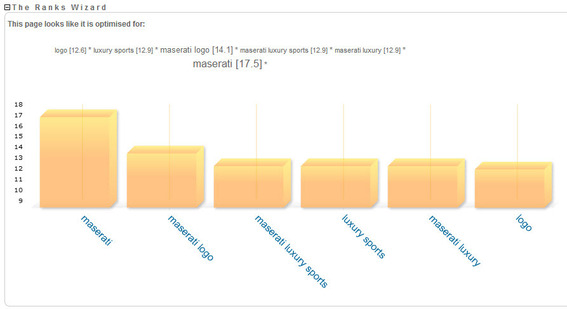When talking to marketers, it can be nearly impossible to get them to look beyond the brand imagery and user experience they’ve crafted for their customers online. And while they’re locked into that perception of their sites, it’s very difficult to explain why search engines don’t perceive their sites exactly as they do. These four simple visuals can help shatter those perceptual walls and open the door to more productive SEO discussions.

This is the Maserati website as you see it.

This is the Maserati website as search engine crawlers ‘see’ it.

Many words, few with strong keyword relevance. Notice how small ‘luxury,’ ‘sport,’ and ‘car’ are compared to ‘maximum,’ ‘speed,’ and ‘output.’

And out of all of those words, these phrases send the strongest keyword signals to the search engines. Is this consistent with what we’re trying to rank for?
Seeing the Site Like a Search Engine
This first step is critical to helping marketers understand that search engines view the world fundamentally differently than they do. They may understand this cerebrally, but until they see the difference between their beautifully crafted sites and the bare bones HTML a crawler perceives, they can’t really believe the scale of the difference.
To see the difference for yourself on any site, just disable your browser’s JavaScript, CSS, cookies and images, and display the alternative attributes for the images. These actions can be accomplished most easily using Firefox and the Web Developer Toolbar plugin. See “SEO: Try Surfing Like a Search Engine Spider,” my earlier article, for complete instructions.
Creating a Keyword Tag Cloud
Still, seeing through the eyes of a search engine crawler is a bit too foreign. So after explaining the different sections of HTML that the crawler sees — in the Maserati example, an overly heavy focus on countries and languages — I switch gears and show a tag cloud built from the same words found in the HTML that the crawlers see. The tag cloud makes the very same text more accessible, making it very easy to digest the concept of keyword density, the relative number of times individual words are used on the page.
To make the tag cloud depicting keyword density, copy the text from the plain HTML version of the page that the search engine crawlers see and paste it into your favorite tag cloud tool. Check out Wordle for a basic tool with a focus on attractive formatting; or use Tagxedo for tons of options on which words to include/exclude, nifty shape choices — and fonts and colors galore.
Refocusing on Keyword Prominence
Keyword density is easy to understand but it isn’t as important to SEO as keyword prominence, which focuses on where the keywords are used on the page. For example, using a keyword phrase at the beginning of the title tag is more prominent to search engines than using it at the end of the body copy, which in turn is more prominent than using the keyword in an image’s alternative attribute.
The Ranks Page Analyzer crawls a specified page to break down the keyword density and prominence. The chart above is a screen capture taken directly from the tool’s output. It also features charts that identify which words are found together in two-, three-, and four-word phrases.
For example, the Ranks Page Analyzer shows that the Maserati home page contains the words “luxury,” “sports” and “cars” tree times each: once in the title tag, once in the meta description and once in the body copy. However, nowhere on the page or in the metadata are the words “luxury cars,” “sports cars,” or “luxury sports cars” used as exact phrases. These keyword phrases are highly valuable, and using them as exact phrases more optimally on the home page would likely result in higher rankings.

Average monthly searches in Google for Maserati-related keywords.
Today Maserati ranks 7 in Google for “sports cars” behind Nissan, 10 for “luxury cars” behind Lexus, Cadillac and Mercedes-Benz, and 3 for “luxury sports cars” behind reviews sites. That’s pretty good, actually, in a very competitive space. But if I were to explain to the executives at Maserati why they weren’t ranking higher or driving more organic search traffic, these four visuals would start the discussions on the most productive foot possible.
Many, many other factors besides keyword density and prominence are involved in organic search performance. Linking factors, structural factors, other keyword and contextual factors, hundreds of these signals factor into each engine’s organic search algorithms. Still, in working with clients large and small, SEO-savvy to inexperienced, I’ve found time and again that starting the conversation with these four visuals establishes the open mind and shifted perception required to discuss SEO challenges and solutions productively.





